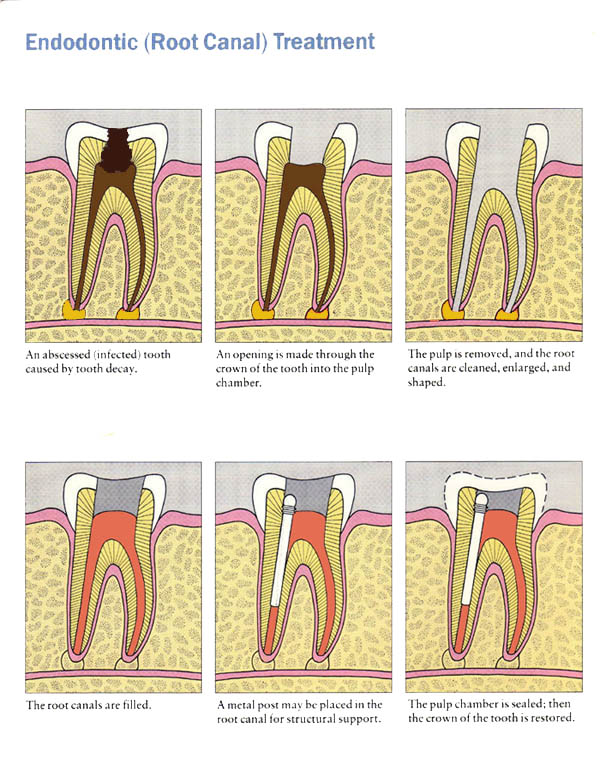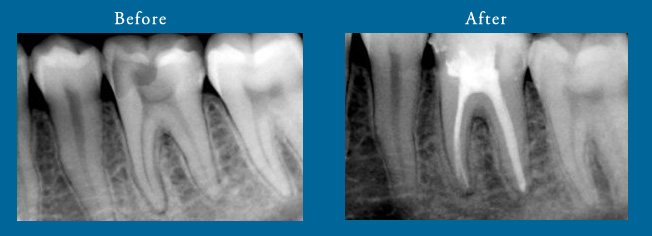

A root canal treatment is needed when there is infection or injury to the central part of the tooth called the pulp. Teeth with diseased or injured pulps which were extracted earlier, can now be saved. At Kakatiya Dental,our experienced Dental Specialists make this procedure comfortable, quick and absolutely painless!
During Root Canal Treatment the dentist removes the pulp, which is situated in the centre of the tooth. Then the tooth is cleaned thoroughly, filled and sealed. Since the tooth becomes brittle after root canal, a crown or a bridge is placed on it to prevent it’s fracture.
At Kakatiya Dental we have highly experienced Endodontist i.e. Dentist who is specialized in Root canal treatments who can perform the entire procedure in a single visit. A properly done root canal with a cap can last for a lifetime. We use the latest technology, like rotary system and Rvg,which provides our patients with the best quality at an affordable cost.
Our Root Canal Specialist use the latest technology and advanced pain management techniques to make treatment painless, comfortable and affordable. Schedule an appointment to receive a consultation and get an exact price quote for your root canal treatment

Whether the people know what is a root canal or not, what they know is that it is synonymous with pain. The idea that a root canal is the most painful of dental surgeries is a myth. The procedure can save a dying tooth and prevent the need for an artificial tooth.
A root canal is a hollow cavity within the tooth that houses the vital part of the tooth-the pulp. The pulp provides nutrition to the tooth via the blood and is also responsible for tooth sensitivity because of the presence of the nerves.
If a canal ever gets infected, which generally occurs when tooth cavities destroys the enamel and dentin, the pulp gets exposed to the outer environment. At this stage the patient feels an intense pain that might even radiate to head and ear, sensitivity to hot and cold and discomfort. If left untreated, an infection occurs causing the death of the pulp and also infection of the surrounding bone. The stage is usually associated with the inability of the tooth to withstand chewing forces. Unless still treated, this pain will likely remain and could result in the tooth eventually falling out.
In order to prevent tooth loss, a root canal surgery must be performed. The surgery is designed to clear out diseased material from inside the canal. To perform a root canal surgery, a hole is drilled into the tooth to allow access to the inner pulp. The diseased pulp is completely removed with special instruments, and the cavity is usually filled and capped with specific inert material.
The success rate of root canal surgery is high. Only 5% of the cases typically require remedial treatment. Complications usually involve re-infection of the pulp from diseased tissue that was inadvertently left behind. A re-infection of the tooth could mean either another root canal surgery or the loss of the tooth.
After the surgery, the tooth will remain sensitive to pressure for 2-3 days so chewing hard foods on it is not recommended for that period. However, a successful root canal surgery can restore a patient's ability to chew without continuous pain or the possibility of losing that tooth.
If you have excessive tooth pain, be sure to consult your dentist today about a root canal surgery.
Restoration of an RCT treated tooth- Post and Core.
After RCT it is mandatory to put a crown over the treated tooth. However, RCT treated teeth present specific restorative problems because they frequently have insufficient healthy tooth structure remaining to retain the final restoration. Due to loss of tooth structure and RCT treatment, the tooth becomes brittle and prone to fracture. Various techniques are now available to address these specific problems. These techniques use special pins called as the dowels to provide necessary retention for the cores and to prevent separation of the crown from the root.
The post and cores are available as prefabricated posts or may be individually cast both for anterior and posterior teeth. The procedure involved is simple though technique sensitive. A properly selected case and dowel technique plays an important role in the reinforcement of the tooth
Root canal treatment (RCT) saves an infected or decayed tooth by removing the pulp and sealing it. Kakatiya Superspeciality Dental Hospital provides painless root canal treatments using advanced techniques.
Modern root canal procedures are nearly painless with local anesthesia. Our root canal specialists ensure maximum comfort during the treatment.
Most RCTs are completed in 1–2 sittings, depending on infection severity. At Kakatiya Superspeciality Dental Hospital, we also offer single-sitting root canal treatments.
The cost varies based on tooth location and complexity. Our dental clinic offers affordable root canal treatments with high success rates.
With a crown placed after RCT, the treated tooth can last a lifetime with good oral hygiene.